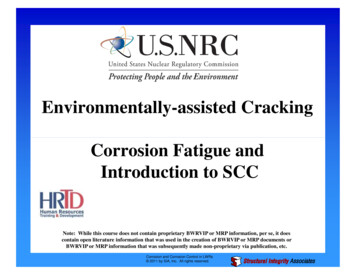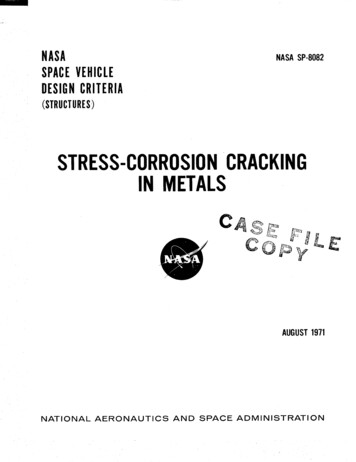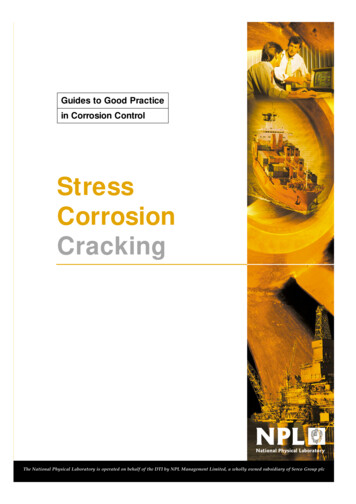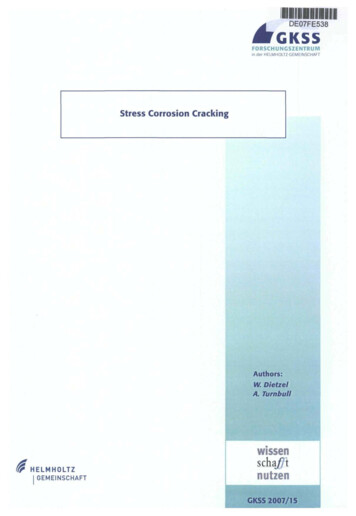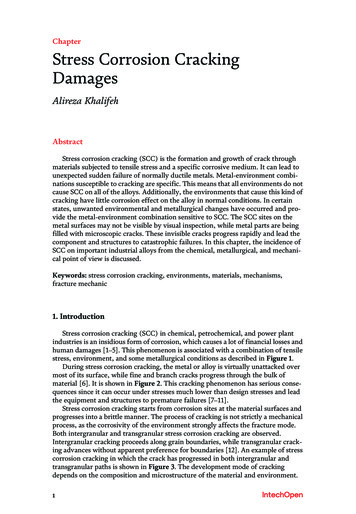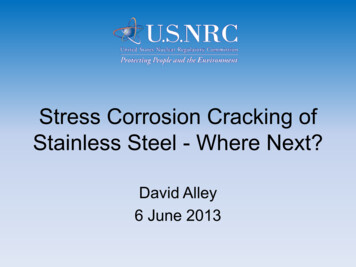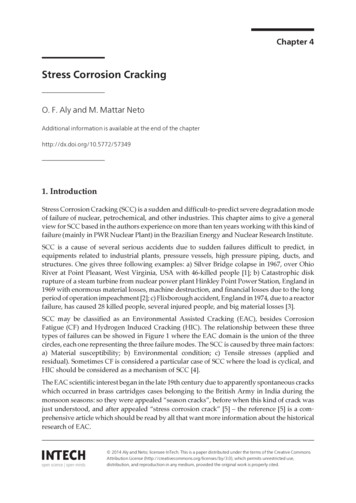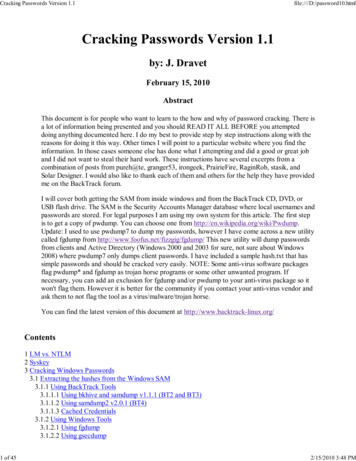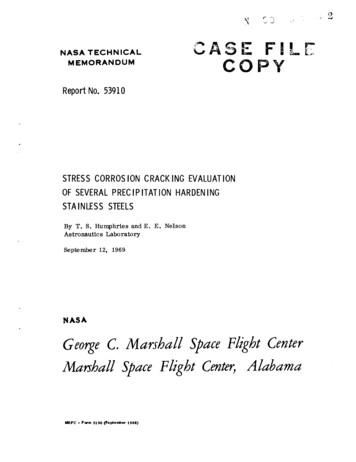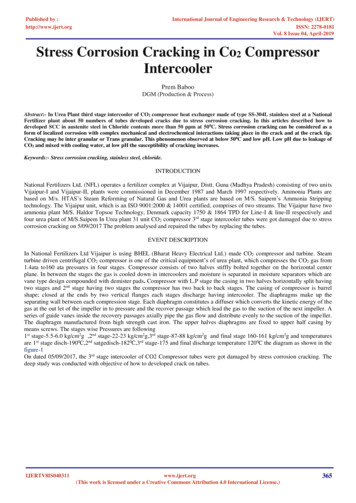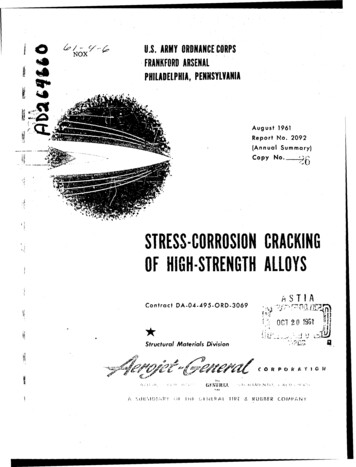
Transcription
0OU.S. ARMY ORDNANCE CO RPSFRANKFORD ARSENALPHILADELPHIA, PENNSYLVANIAAugust 1961Report No. 2092(Annual Summary)Copy No. r12STRESS-CORROSION CRACKINGOF HIGH-STRENGTH ALLOYSContract DA-04.495-ORD-3069 IOCTiS r T IA20 11 Structural Materials DivisionACf0litl iIllZ'RVIFy
Report No. 2092August 1961r (Annual Sum ary)INVETIGATION OF STRESS-C(WROSION CRACKIN3OF HIGH-STRENGTH ALLOYSIIContract DA-04-495-CRD-3069IUUIWritten by:R. B. RobinsonR. J. UzdarwinIApproved by:No. of Pages: 73Period Covered:1 July 1960 through 30 June 1961R. F. KimpelHead, MetaJllics & Refractories SectionResearch and Engineering Dept.Structural Materials DivisionAEOJET-GENERAL CRPORATIONAzusa, California
Report No. 2092FOR37CRDThis report isDA-O4-495-ORD-3069.based upon work performed on U.S. Army Ordnance ContractItwhich represents the firstcovers the work period 1 July 1960 through 30 June 1961,half of the contractual effort.The investigation wasmade at the Structural Materials Division Development Laboratories o. AerojetGeneral Corporation, Azusa, California.This contract was administered under the direction of the U.S. ArmyOrdnance Corps.,Frankford, Arsenal, with Mr. H. Rosenthal acting as ProjectEngineer.The authors are gratefully indebted to Dr. E. H. Phelps and Mr. A. W.Loginow of the United States Steel Corporation for their invaluable technicalassistance inthe design of the test fIixtures and the methods used in thisinvestigation.Page ii
Report No. 2092ABSTRACTSix high-strength alloys were evaluated for stress-corrosion susceptibilityinenvironments representative of those environments to which the alloys arenormally exposed during the manufacture, hydrostatic testing, and storage ofsolid--rocket-motor cases.The alloys were heat-treated or cold-rolled to yieldstrengths ranging from 194,000 to 278,000 psi.The environmental stress-corrosionstudies were conducted with bent-beam and U-bend specimens,specimens stressed to 75% of the yield strength.observed with the Ladish D6AC,Type 300M,with the bent-beamSignificant failures wereand Vascojet 1000 alloy steels in theenvironments of distilled water, tap water,salt water, and high humidity.Vascojet 1000 alloy was the most susceptible to stress-corrosion failure.TheNofailures were observed with any of the other environments or alloys tested.PAIIPage iii
SiIReport No. 2092 CONTEWTSPageContract Fulfillment StatementII INTRODUCTION1II.DISCUSSION2III.EXPERIMENTAL PROCEDURE AND RESULTS2A.Alloys and Environments Tested2B.Test Procedures5C.Environmental Test Results8D.Discussion of ResultsIiIV.11SUMMARY AND CONCLUSIONS13TableAnalyses of Alloys, Vendor and Aerojet DeterminedList and Source of Environmental Chemicals1 2Water-Sample Analyses3Mechanical Properties of Ladish D6AC Test Specimens4Mechanical Properties of Type 300M Test Specimens5Mechanical Properties of Vascojet 1000 Test Specimens6Mechanical Properties of AM355 Stainless Steel Test SpecimensMechanical" 7oroperties of PH 15-7 Mo Stainless Steel Test SpecimenMechanical Properties of B12OVCA Titanium Test SpecimensJI89Strain-Gage Evaluations1OBent-Beam Stress-Corrosion Test Data, Air11Bent-Beam Stress-Corrosion Test Data, Distilled WaterU-Bend Stress-Corrosion Test Data, Distilled Water1213SBent-Beam Stress-CorrosionI-Test Data, Tap Water14U-Bend Stress-Corrosion Test Data, Tap Ilater15Bent-Beam Stress-Corrosion Test Data, 0.254 Sodium Dichromate Solution16U-Bend Stress-Corrosion Test Data, 0.251 Sodium Dichromate SolutionBent-Beam Stress-Corrosion Test Data, i4 Marquench Salt Solution , ,1718U-Bend Stress-Corrosion Test Data, 14 Marquench Salt Solution19Page iv
Report No. 2092C0Ts(cont.)TableBent-Beam Stress-Corrosion Test Data, 3% Sodium Chloride Solution20U-Bend Stress-Corrosion Test Data, 34 Sodium Chloride Solution21Bent-Beam Stress-Corrosion Test Data, Trichloroethylene22U-Bend Stress-Corrosion Test Data, Trichloroethylene23Bent-Beam Stress-Corrosion Test Data, Cosmoline24U-Bend Stress-Corrosion Test Data, Cosmoline25Bent-Beam Stress-Corrosion Test Data,U-Bend Stress-Corrosion Test Data,4W Soluble Oil Solution45 Soluble Oil SolutionBent-Beam Stress-Corrosion Test Data, High Humidity262728FigureTensile Specimen Diagram1Tensile Stress in Strip Corrosion Specimen2Tensile Stresses in Bent Beams for Steel over a 7.00-inch Span3Tensile Stresses in Bent Beams for Steel over a 4.00-inch Span4Tensile Stresses in Bent Beams for Titanium over a 4.00-inch span5U-Bend Test Specimen6Mechani.al Properties of Ladish D6AC Alloy Steel7Mechanical Properties of Type 300M Alloy Steel8Mechanical Properties Of9"'.C.4- 1000 Alloy SteelMechanical Properties of AM355 Stainless Steel10Mechanical Properties of Ph 15-7 Mo Stainless Steel11Mechanical Properties of B12OVCA Titanium Alloy (Longitudinal)12Mechanical Properties of B12OVCA Titanium Alloy (Transverse)13Microstructure of Testing Alloys14Schematic of Specimen Holder15Test Specimen and Fixture Before Testing16Test Specimen Stressed in Fixture Across 7.00-inch Span17Test Specimen Stressed in Fixture Across 4.00-inch Span18Environmental Stress-Corrosion Laboratory19Specimens Undergoing Environmental Stress-Corrosion Testing20Page v
]AReport No. 2092CONET (cont.)Figurein FixtureTensile Specimen with Strain Gage Mounted, StressedFailureVascojet 1000 Alloy Steel Specimens AfterFractured Surface of Failed Specimen, Mag 15XCross Section of Fractured SurfaceHolder andPotential Between 304 Stainless Steel SpecimenVascojet 1000 Specimen in Tap Water2122232425Page vi
iSCONTRACT FULFIWMNT STATEMENTThis annual summary report issubmitted in partial fulfillment of thecontract.Page vii
Report No. 2092I.INUR0DUCTIONThis history of rocket development and the present-day urgency associatedwith reliability and performance of rocket systems attest to the fact that highstandards in all critical areas must be raised even higher for further advancement.The efficiency required of ultra-high-thrust rocket motors designed to propel largepayloads into space dictates that extreme measures must be taken in weight savingsby reduction of non-payload weight.In order to achieve some significant weight reduction of the mass ofmaterials (non-payload weight) required to construct solid rocket cases, highstrength alloys have been developed.At the present time, the alloys in the high-ctrength category that have been most highly developed are of ferrous base.alloyworkedmartensitic stee]lLow-silicon-modified 4300 series, hot-worked die, cold-precipitation-hardened(PH)stainless steel comprise the classes of steelsthat fall within the high-strength category.In the lightweight, high-strengthcategory are the titanium alloys.Although these alloys have excellent mechanical properties and are capableof meeting designs with high stress requirements,istheir performance reliabilitynot always satisfactor;.Frequently, during hydrostatic and other pressurization tcoting, prematurefailures are experienced.sound pressure vessels.invariably isThese failures occur with presumably metallurgicallyAnalyses of these failures indicate that stress corrosionthe causitive mechanism.This program isdesigned to study the susceptibility to stress corrosionof high-strength alloys contemplated for use as rocket-motor case materials.Thecandidate materials were exposed to environments that are representative ofthose that would exist during some phase of the manufacturing,testing, and long-term storage of solid rocket chambers.Page 1
I Introduction(cont.)Report No. 2092The effect of material parameters such as composition, strength level,welding, microstructures, and surface conditions on stress corrosion were exploredin this investigation.II.DISCUSSIONBroadly, the term stress corrosion includes any combined effect of stressand corrosion on the behavior of materials.The principal factors involved instress-corrosion cracking are stress, environment, time, and the internal structureof the material. The importance of these factors varies, and they may interact,one exhilerating the action of the other.Ifstress-corrosion cracking occurs,there must b6 tcnsile stresses at the surface.These stresses may be residual(inte.-nal) or applied. Generally, internal stresses are produced by non-uniformdeformation of the metal during cold working, by unequal cooling from hightemperatures, and by internal structural rearrangements involving volume changes.These concealed stresses generally are of greater importance than applied stresses,especiall.y in view, of the factor of safety used in design of pressure vessels.The magnitude of stresses varies from point to point within a stressedcomponent,but in order to promote stress-corrosion cracking, tensile stresses inthe neighborhood of the yield strength of the material are usually required. Thereare, however, reported failures that occur at applied stresses well below theyield strength of the metals.Stress-corrosion cracking has been observed in almost all metal systems;yet, for each metal or alloy, stress-corrosion cracking is associated with specificenvironments.The environments that induce cracking usually attack the metal ina superficial manner when stresses are absent.The time to stress-corrosion failure of metallic components may vary fromminutes to years, but accelerated laboratory tests may be employed to study thesusceptibility to the stress-corrosion cracking of numerous alloys.relativeIII.JW(PTFRMLWq'TkL PPROCEDURE A-AfD RESULTSA.aSlloy,;,ALLOYS AND 1XVIRONMENTS TESTIFIn accordance with the contractural agreement, six vacuum-meltedrepresentative of the following classes of rocket-motor-casc materi-ln,Page 2
!IIF.'perimental Procedure and Results,were procured and tested:A (cont.)Report No.2092low-alloy martensitic steel, silicon-modified 4300series steel, hot-worked die steel, cod-worked PH steel, precipitation-hardeningstainless steel, and a high-strength titanium alloy.Twelve different environments were chosen as being typical of the naturalenvironmentsto which the rocket-motor cases are exposed during fabrication,hydrostatic testing,1.and storage.Specific Alloys and ProducersThe specific alloys tested and the respective producers are asfollo01ws:a.Ladish D6AC (low-alloy martensitic steel),AllegheneyLudlum Steel Corporationb.Type 300M (silicon-modified 4300 series steel),AllegheneyLudllui, Steel Corporationc.Vascojet 1Q00 (hot-worked die steel), Vanadium Pacificd.AM355 (cold-w,,orked PH steel), Wallingford Steel Companye.PH 15-7 Mo (precipitation-hardeningSteel Companystainless steel),Uallingford Steel Companyf.B120VCA titanium (high-strength beta titanium alloy\Crucible Steel CompanyTable 1 gives a comiprehensive analytical summary of all sixalloy-s.2.Selection of EnvironmentsThe following environments were used to study the stress-corrozion-cracking susceptibility of the alloys tested.a.Atmosphere (air) was used as a standard environmentagitinrt which all of the other en"iro.mental tests could be compared.b. ,girYstDistilled water was also used as a standard environment ihich all of the other environmental tests could be compared.Page3
III Experimental Procedure and Results,c.A (cont.)Report No. 2092Tap water represents the medium frequently used to cleansolid-propellant-rocket-motorcases.This fluid isalso used inthe hydrostatictesting of pressure vessels, particularly those chambers constructed of corrosionresistant alloys.Ud.Inhibited water (0.251 by weight sodium dichrcmate solution) represents the medium frequently used to flush solid-propellant-rocketmotor cases and inthe hydrostatic testing.of pressure vessels, particularly thoseconstructed of low-alloye.solution),steels.HeAt-treating salt solution (1i by weight marquench salta mixture of nitrites and nitrates,temrerature qienching media inisused as constant-elevated-the heat treatment of certain rocket-motor casematerials.f.Salt water (3% by weight sodium chloride solution) wasused to simulate a moderately severe marine environment.g.A chlorinated degreasing solvent (trichloroethylene) waschosen as a representative en.vironment to test the effect of chlorinated degreasing solvents on rocket-motor-case materials.h.A rust-inhibiting oil, E. F. Houghton's Ccsmolinie 377,conforming to MIL-C-14201A, Grade 2, i.ras used as the rust preventive compound forrocket-motor cases during the manufacture,transit, and li i-ted storage prior toSpropellvant installation.i.An aqueous soluble-oil solution (4% by volume Chevronsoluole oil) represents one of the fluids used inthe hydrostatic testing ofpressure vessels, particularly those constructed of corrosion-resistant alloys.j.The hydrocarbon-base oil represents a hydrostatic testfluid to replace agucous solutions.t.High hinmidity was used in accelerated testing to simulat,,;e erc atmospiheric conditions.1.com1ozItiruSolid propellants often undergo a certain amount of de-during long-term storage of solid-propellant-rocket motors.The purposePage 4
III &xperimental Procedure and Results,of investigating this environment isA (cont.)Report No.2092to determine the role that the decompositionproducts of the solid propellants play inthe stress-corrosion behavior of therocket-motor-case materials.Table 2 listsallenvironments and the source of each.of the chemicals used in the makeup of theseT'.ble 3 gives a typical analysis of tap anddistilled water samples taken from the same sources as the water used inthe en-viroinental testing.B.TEST PROCEDURESBoth be6t-beam specimens (stressed to a prcdetermined level) andU-bend specimens were used intibilitythis investigation to determine the relative suscep-to environmental stress-corrosion of the various high-strength alloystested.1.Specimen PreparationTest specimens were prepared by blanking 1 x 8 in.Prom sheet material of each alloy.couponsThe specimens were heat-treated to the desiredstrength levels and finish-ground to appropriate specimen thicknesses and ength--s.The length of each specimen was determined from the yield strengths of the alloysand the specimen thickness in a manner described later in a section under "StressDeterminations."The mechanical properties of each alloy were obtained by pullingtensile specimens (see Figure 1) on a Baldwin-Tate-ElueryUniversal testingmachine.By employing a Peters Th:tensometer and a Baldi-.n stress-strain recorder,stress-strain curves were obtained frcm which the 0.2% offset yield strength wasccmputed.In order that allof the alloys be pu on an equal basis for comparisoncf the stress-corrosion test results, 0.2M offset yield strengths of 20C,000 to24ou.cCo psi vere aimed for inthe ferrous-base alloys.give ztrength levels equivalent to those obtained ini:eight ratio basis.The titaniim was aged tothe steels on a strength-to-After heat treating, the low-alloy steel specimens were preparedto 0.060 -0.005 in.g.-l.ýndC" *ethickness and a 32-rms finish by surface grinding.Lu give a specimen width of 1.00 in.The edgesThe specimens were then cu-t 'intoPage 5
ISIIIExperimental Procedure and Results, B (cont.)Report No.2092lengths to give a maximum surface tensile stress of 75% of the yield strengthover a 7-in. span for the bent-beam tests.The stainless steel alloy specimensifere prepared by shearing to a width of approximately 3/32 of an in.1 in.,and then carefully grinding to 1.00 in.inwidth.'greater thanSince the material wasthin (0.030 to 0.040 in.), the shorter 4-in.-span test fixture was used.Thespecimenr,: were cut into lengths to give a maximum surface tensile stress of 750 ofthe yield strength over a 4-in.span for the bent-beam test.As with the stainlessthe titanium alloy specimens were prepared by shearing to 1-in.steel alloys,widths and then grinding to lengths to give a maximum surface tensile stress of75% of the yield strength over a 4-in. span for the bent-beam test.The appropriate length of the specimens was determined by ashown graphically inrelationship,Figure 2, between the strain inthe specimen length, the specimen thickness,fibers at the middle of the specimen,and the holder span.the outerThis relationship isbased on the exact solution for anD- assuzing a constant modulus of elasticity and span length,elastic beam.2 was modified to produce the curves shown inFigures 3, 4, and 5.FigureFigure 3 isthe gr-aph of tensile stresses in bent beams at varying lengths for various beamthicknesses,assuming the span to be 7.000 in.st.eel) to be 30 x 10psi.beams over a 4-in. span,and the modulus of elasticity (forFigure 4 illustrates the same relationship for steeland Figure 5 for tita'nium beamns over a 4-in. span.In addition to the bent-beam specimens,also employed.U-bend specimens wereThese specimens were prepared by bending the specimen over 12T-and 24T-dia mandrels until the two sides were separated by a distance equal tothe diameter of the mandrel; then, the specimen was held inby " bolt through holes drilled ina stressed conditioneach end (see Figure 6).The hpat-treat schedules and the mechanical properties of allof the alloys tested are summarized ininFigures 7 through 13.Tables 4 through 9 and depicted graphicallyFigure 14 illustrates some of the typical microstructuresof the various alloys tested.The microstructures indicate that each alloy r -sponr&! normally to the treatment itJevek .was given to produce the desired strengthPage6
III Experimental Procedure and Results,2.B (cont.)Report No. 2092Testing MethodsIn this investigation,ithas been endeavored to reproduce asnearly as possible the environmental conditions that exist inthe manufacturing,hydrostatic testing, and long-term storage of rocket-motor cases,and to studythe susceptibility of several high-strength alloys to stress-corrosion crackinginthe various environments.The environmental stress-corrosion studies wereconducted with bent-beam and U-bend specimens,with the bent-beam specimensstressed to 75% of the yield strength.A schematic diagram of the 304 stainless steel specimen holderused inthe bent-beam tests ispresented ina specimen prior to stressing isspecimens stressed inshown inFigure 15.Figure 16.The specimen holder andFigures 17 and 18 illustratethe specimen holders.The environmental stress-corrosion laboratory isFigre 19, anA Figure 20 isSStressshown ina detailed illustration of an environmental chamber.DeterminationsThe stress setup within an elastic body isstrain to which the body isproportional to thesubjected by the applied load according to Hooke'sL . which may be rewritten asstress k x strainwhere k isa constant for the material of the elastic body.This constant isKncwn as the modulus of elasticity of the material, and for most steel alloys isgenerally taken as 30 x 106 psi.Flat-beam specimens are used in the particular method andtech aqusemployed ininvestigated inbpecimen isstudying the stress-corrosion behavior cethe alloys beingthis program.The amount of tensile stress induced in thedirectly proportional to the distance that the beam isdeflected."This deflection, in.turn, depends upon the length 6f the bent beam across a known(0jIsr)xnce.The stress can therefore be determined if:;nd the distance across which the beam isbcth the length of the beamdeflected are known.Page 7
III Experimental Procedure and Results,Report No. 2092B (cont.)The stresses were determined from tables of tensile stressesin bent beams as prepared by Dr. E. H. Phelps of the United States SteelCorporati on.In. order to obtain a more accurate reading of the actualTatnall c6-141 foil-type strainstresses obtained in the bent-beam specimens,gages, mounted longitudinally in the center of the top surface of selectedspecimens (see Figure 21), were used to make a spot check. The strain-gagereadings were taken both before and after the specimens were stressed.strain of the deflected beam was obtainedinmicroinches,tensile stress was computed by employing Hooke's Law.The actualand the maximum inducedHowever, the valuesobtained by the strain-gage method were considerably higher than those calculatedfrom the U.S. Steel tables (see Table 10).A probable reason for the discrepancy observed between thetheoretical and measured values lies in the fact that some plastic deformationof the specimens had occurred.Inspection of the stress-strain curves recordedduring the-mechanical testing of Vascojet 1000 tensile specimens reveal that theproportional limit of this alloy is about 50 to 601 of the 0.2M offset yieldstrength.Since the flat beams were bent to get a maximum tensile stress of 751of the 0.2M offset yield strength, the proportional limit has been surpassed andsome plastic deformation has occurred.bent beams are valid only ifInasmuch as tables of tensile stresses instress does not exceed the proportional limit ofthe material, proper comparison cannot therefore be made bet-een the theoreticaland the measured strain values.Evidcnce of plastic deformation in the specimensis taken from the observation that the specimens do not return to their original-,atness but retain a si--ght bow in the center.C.ENVIROMENTAL TEST RESULTSIn order to be better able to draw a clear comparison of all of thealloys tested, each environment will be treated individually.The bent-beamspecimens were tested in triplicate and the U-bend specimens were tested indupl. cat e.1.AirBent-beam specimens of each alloy were exposed in air for aoper!of four weeks.None of the specimens failed in this environment (seeFage 8
III Experimental Procedure and Results, C (cont.)Table 11).Report No. 2092The average measured temperature of the air was 7h4F, ranging from alow of 62 F to a high of 92 0 F.The measured relative humidity averaged 50o,r'anging from a low of 16ý to a high of 744.2.Distilled WaterIn general,this environment was found to be the most corrosiveThe reasons for this are not clear.of all the environments tested.comparison can be drawn between distilled water and tap water.water ismore acidic than tap water,sion than does the tap water.itthe bent-beam specimens was Vascojet 1000.steels failed indistilled water.aSince distilledhas a greater tendency to promote corro-The only alloy that failed inhigher strength levels (see Table 12).However,distilled water withThese failures occurred only at theU-bend specimens of allAs was expected,three-low-alloyVascojet 1000 was the leastresistant to stress-corrosion cracking (see Table 13).Red and black oxides ofiron formed on all three of the low-alloy steels in the distilled water.3.Tap U1aterFailures with the Vascojet 1000 alloy bent-beam specimens andVascojet 1000 and Type 300M alloy U-bend specimens were observed in(see Tables 14 and 15).However,than that of the distilled water.tap waterthe time to failure was considerably longerAgain,iron oxides formed on allthree of thelow-alloy steels.4.Sodium Dichromate SolutionNone of the alloys failed in this environment inthree weekswith either the bent-beam or with the U-bend test specimens (see Tables 16 and 17).Thir- chromate solution inhibited the fornation of any surface corrosion on thelow-alloy steels.5.Marquench Salt SolutionNone of the alloys failed in this environment inthree weekswith either the bent-beam or with the U-bend tect specimens (see Tables 18 and 19).Sunie slight rusting of the Type 300M alloy specimens was observed.Page 9
iiMExperimental Procedure and Results, C (cont.)6.Report No. 2092Sodium Chloride SolutionFailures with the Vascojet 1000 alloy bent-beam specimens andallthree low-alloy steel U-bend specimens were observed inTables 20 and 21).distilled vrater.this wanThe time to failure w.as approximately the same as that of theTable 20 shows some failures of the titanium alloy.-.ttrib.tedHowever,to faulty specimens and not to stress-corrosion cracking.Oxides of iron were noted on all7.this environment (seethree of the low-alloy steels.TrichloroethyleneNone of the alloys failed inthis environment inthree weekswith either the bent-beam or the U-bend test specimens (see Tables 22 and 23).Table 22 shows Gome failures of the titanium alloy.However,this was attributedto fau-Ity specimens and not to stress-corrosion cracking.8.CosmolineNone of the alloys failed inthis environment inthree weekswith either the bent-beam or the U-bend test specimens (see Tables 24 and 25).ComDlete rust inhibition.on the low-alloy steels was observed.9.Soluble Oil SolutionNone of the alloys failed inthis environment in three weekswitih tIther the bent-beam or the U-bend test specimens (see Tables 26 and 27).No corrosicn of the low-allcy swteels was observed.10.Hydrocarbon-base OilNo testing w.as accomplished inthis environment.Ladish D6AC steel was the only alloy tested inthis environment.Bent-beam specimens of this alloy failed at the higher-strength levels (see Table28).Tie humidity conditions consisted of air saturated with water vapor at190FF-15 F.Severe rusting of the specimens was observed.12.Solid PropelantsNo testing was accomplished inthis environment.Page 10
iII Experimental Procedure and ResultsD.(cont.)Report No. 2092DISCUSSION OF RESULTSWhen a stress-corrosion failure occurs in the field, the firstproblem is one of diagnosis.Ithas been found that for each alloy, there arecertain environments that induce stress-corrosion cracking.In the event offailure, the possibility of an environment known to promote cracking should beinvestigated.Unfortunately,itis not safe to assume that all other environ-ments are ineffective,There are several principles involved in reproducing stress-corrosioncracking failures in the laboratory.of service conditions.not easily simulated.However,The first requirement isthe reproductionsurface stress conditions are often complex andAlso, tests must be of reasonable duration.Finally,putting a quantitative figure on the damage that has occurred in the test is nota simple matter.The most important factors are time, the nature of the stress,the condition of the metsland the environment.There are no universally accepted tests for determining susceptibilityto stress-corrosion cracking.In most cases,cracking is sought in tests in which, ifthe evaluation of stress-corrosioncomplete fracture of the specimen occurs,the measurement recorded is the time for rupture to occur.case in this investigation.ItSuch has been thewill be noted that mobst of the failures haveoccurred with the low-alloy steels, heat-treated to the higher-strength levels.These failures occurred only in aqueous envroments to w hich no inhibitors hadbeen added.Itis apparent from the environmental stress-corrosion test datapresented herein that some alloys are more susceptible to stress-corrosion thannthran.:to . entihatze more prone to cause stress corrosion thanothers.An analysis of the data will show that distilled water, tap water, saltwater, and high humidity all caused some stress-corrosion failures with the lcw-"alloy steels.(Ladish D6AC, Type 300M, and Vascojet 1000).These failures occur-red, without exception, at the higher end of the strength-level range. It followsfrom this that for any given environment and period of exposure, there exists a'r:.ticalstrength level above which failure will occur by the mechanism of stressor"rosi n,and below which no failures can be expected.After three weeks -fPage 11
IlExpta-imental Procedure and Results,D (cont.)Report No. 2092exposure at a stress level of 75e of the 0.2ý offset yield strength, the criticalstrength level of the Vascojet 1000 alloy lies between 212,000 and 238,000 psi forVFor all of the other environments, it probablythe environments listed above.lies above 242,000 psi. At a stress level of 759 of the yield strength and anexposure time of three weeks,the critical strength levels of all of the otheralloys in all of the environments tested lies above the highest yield strengthsat which each alloy was tested. Similarly, critical strength levels of specimensstressed to 100M of the yield strength (such is the case with the U-band specimenz)for a given environment and exposure period can be estimated from the test data.There exists the possibility that large vessels undergoing hydrostatic testing contain microcracks which lead to rapid failure because of highThese microcracks very oftennotch sensitivity.escape detection.Other in-vestigators have shown that notch-sensitive specimens produce relatively rapidfailures.In addition, the possibility of brittle failure as caused by hydrogenembrittlement cannot be excluded.Further studies should be made on these con-siderations as possible causes of catastrophic failures.Some typical failures of the Vascojet 1000 alloy specimens fromdistilled. water, tap water, and salt water are illustrated in Figure 22.Itwill be noted that failure did not occur in the center of the specimen, where itvas believed the highest stresses existed, but rather at a point somewhat removedfrom the center of the specimen.This lends further evidence to the phenomenathat some plastic deformation had occurred while the specimen was being placed inthe specimen holder.specimen,Figure 23 illustrates the fractured surface of a failedand the cross section of the fractured surface is shown in Figure 24.One further item that merits consideration at this point is theeffect of galvanic currents upon stress-corrosion failure.During the course ofthis investigation, the question was raised concerning the magnitude and theffects of the various alloys and the stainless steel specimen holders duringenvironmental testing.Consequently; an investigation was conducted to determinejast what this galvanic effect would be on the stress-corrosion failure of thealloys tested.The galvanic currents between Vascojet 1000 alloy specimens andone of the 304 stainless steel specimen holders was measured in tap water andd*itiAlPd water.Virtually no potential was observed in the distilled water.Page 12
I*III Experimental Procedure and Results, D (cont.)However,Report No. 2092-the tap water produced a potential of about 200 my.,the Vascojet 1000being anodic to the 304 SS (see Figure 25).IV.n1'SU IMRY AmD CONCLUSIONSBased upon the screening tests performed d
stress-corrosion cracking are stress, environment, time, and the internal structure of the material. The importance of these factors varies, and they may interact, one exhilerating the action of the other. If stress-corrosion cracking occurs, there must b6 tcnsile stresses at the surface. .
